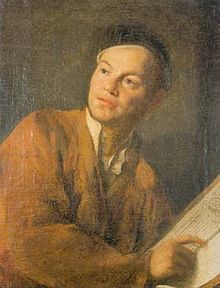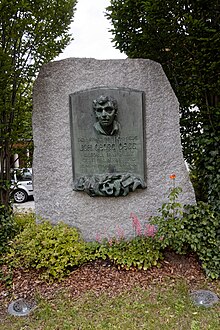Johann Georg Oegg


Johann Georg Oegg (born April 24, 1703 in Silz (Tyrol) , † October 15, 1782 in Würzburg ) was an Austrian prince-bishop's court locksmith and blacksmith who worked in Vienna and Würzburg. Among other things, he created the gates of the gardens on behalf of Prince Eugene for his Belvedere palaces in Vienna and the Hof Palace and, on behalf of three or four Prince-Bishops, Würzburg's gates for the courtyard of the Würzburg Residence and its adjoining court garden .
life and work
Johann Georg Oegg came from a family of blacksmiths. His father was the master blacksmith Michael Niccolo Oegg in Silz in Tyrol, his brother Peter Oegg and the husband of his sister Cäcilia, Jakob Heusing, were master locksmiths in Linz on the Danube. Here Johann Georg learned the blacksmith's trade from his uncle Peter Oegg.
After his apprenticeship and hiking time he worked as an art fitter on the buildings of Prince Eugene of Savoy in Vienna and Schloßhof / March together with Christian Kermer. The main responsibility was still entrusted to the metalworking shop Arnold and Conrad Kiefer based on Hildebrandt's drawings .
The Würzburg prince-bishop Friedrich Karl von Schönborn (1674–1746) appointed him to his court in 1733. Here he was supposed to be responsible for the design and manufacture of locks and fittings for the new building of the Würzburg Residence and also for the manufacture of all the decorative grilles for this large building.
Oegg brought his journeyman Markus Gattinger with him from Vienna , who later married a master locksmith's widow in Würzburg and thus also became a master.
Oegg's first test work in Würzburg was two small door panels on the street portal of the Schönborn Chapel at Würzburg Cathedral (1734) and the two lattice gates at the entrances from the cathedral to the Schönborn Chapel (1734/35).
His first major work in Würzburg is the skylight grille (lunette grille) over the entrance to the south block of the residence. In addition to extensive, then still strictly symmetrical decorations, the lattice also contains the initials of Prince-Bishop and Imperial Chancellor Friedrich Carl von Schönborn as well as the ducal and imperial crowns .
In 1736 Johann Georg Oegg joined the Würzburg locksmith's guild as a master. During this time he was mainly engaged in the manufacture of fittings and locks for the residence.
The wrought-iron grilles for the end of the courtyard of the Würzburg Residence, which were Oegg's main work, began in 1735. For this purpose, three lattice gates and 14 fixed side parts were made. The work was so significant that the payments to Oegg from 1739 to 1742 were among the highest expenditure of the court chamber. In 1739 Oegg's workshop employed 26 journeymen.
He created the lattice gates on the side of the residence from 1748 to 1750.
The grid system was probably completed by his son Johann Anton Oegg (1745–1800). It can be assumed that it was completed during the reign of Prince Bishop Adam Friedrich von Seinsheim (1755–1779). Thus, the Oegg workshop carried out locksmith and blacksmith work for four Würzburg prince-bishops.
In 1762, Oegg also made the masterfully designed wrought-iron attachment for the prescription table in the hospital pharmacy of the Würzburg Juliusspital .
In addition to these important art locksmith work, the Oegg workshop also made caskets, riding harnesses, clock faces, sconces, gilding and enamelling , gold, silver and ivory inlays.
The grilles of the courtyard closure made by Oegg were broken off in 1821 on the orders of Crown Prince Ludwig for reasons of contemporary taste and have been lost since then. Only drawings and an engraving are left. The lattice gates to the court garden of the Würzburg Residence, which are among the most important works of their kind, are preserved and famous today.
Johann Georg Oegg died, already widowed, in 1782 in Würzburg. He was buried in the responsible parish church of St. Peter and Paul near the altar "Zum Heiligen Kreuz".
After the church had been largely destroyed in the night of the bombing on March 16, 1945 , some Würzburg master blacksmiths searched the ruins for the grave of Oegg in 1951. In fact, they found the master's remains at the specified location with remains of the leather doublet, leather apron and iron belt buckle.
Works
In Würzburg, his most important works were created at the Residenz and the Schönborn Chapel :
- Door panel of the main portal of the Schönborn Chapel
- Lattice doors between the Schönborn Chapel and the Würzburg Cathedral .
- Completion of the main courtyard of the residence.
- To the north of the residence there is a wrought-iron gate, which was later named Oeggtor after the artist . It leads over the Rennweg and is therefore sometimes referred to as the Rennweger Tor, but should not be confused with the former Rennweger Tor of the city fortifications.
- Another gate to the court garden between the residence and the ambassador's building
- Two more gates to the Hofgarten: the Greiffenclau gate (1746–1752) at the northern entrance (Rennweg) and the gate on the Balthasar-Neumann-Promenade to the south garden.
- Lattice decorations at the northern and southern ends of the Residenzplatz
- Decoration of a lunette grille at the entrance to the southern courtyard of the residence
The following works by Oegg can be found in museums:
- A chamberlain key (around 1760), a chapter cross (1757) and a pair of scissors (around 1760) in the Würzburg Cathedral Treasury
- Two lattice gates of the residence (gate leaves measuring 258 cm by 185 cm) as outstanding objects of wrought iron art in the collection of the Bavarian National Museum.
Oegg House
In 1746, Oegg had a building in Kapuzinerstraße 3 redesigned by Balthasar Neumann as a residential building. After the later owner, Graf zu Bentheim, the building is also known as Hof Bentheim. It was rebuilt according to old plans after being destroyed in the Second World War.
Honors
- Oeggtor: The gate north of the residence belongs to Oegg's main works and bears his name.
- Memorial: The Oegg Memorial is located a few meters from the Oeggtor at the entrance to the Hofgarten. It was created in bronze in 1952 by the sculptor Julius Bausenwein (1913–1962).
- Oeggstraße in Würzburg, branches off from Theaterstraße between Mainfranken-Theater and Rotem Bau.
- Georg-Oegg-Straße in Werneck , a municipality between Würzburg and Schweinfurt
literature
- Verena Friedrich: Oegg, Johann Georg. In: New German Biography (NDB). Volume 19, Duncker & Humblot, Berlin 1999, ISBN 3-428-00200-8 , p. 428 f. ( Digitized version ).
- Wilhelm Lang: Johann Georg Oegg. Prince-Bishop's palace locksmith in Würzburg. A master of blacksmithing. Echter-Verlag, Würzburg 1982. ISBN 3-429-00799-2 .
Web links
Individual evidence
- ^ Object description for the photo: Vienna, Upper Belvedere, gate between the water basin and the Gürtel, ID 180775; UNIDAM Internet database accessed on May 17, 2019
- ↑ Ulrike Seeger: City Palace and Belvedere of Prince Eugene. Origin, shape, function and meaning, Böhlau Vienna, 2004; ISBN 3-205-77190-7 , page 175 / footnote 100
- ↑ Stefan Kummer : Architecture and fine arts from the beginnings of the Renaissance to the end of the Baroque. In: Ulrich Wagner (Hrsg.): History of the city of Würzburg. 4 volumes; Volume 2: From the Peasants' War in 1525 to the transition to the Kingdom of Bavaria in 1814. Theiss, Stuttgart 2004, ISBN 3-8062-1477-8 , pp. 576–678 and 942–952, here: p. 664.
- ^ HG Schwieger and Gottfried Zöbl: The old pharmacy. Bandage material factories Paul Hartmann, Heidenheim / Brenz 1954, p. 42 f.
- ↑ Stefan Kummer : Architecture and fine arts from the beginnings of the Renaissance to the end of the Baroque. In: Ulrich Wagner (Hrsg.): History of the city of Würzburg. 4 volumes; Volume 2: From the Peasants' War in 1525 to the transition to the Kingdom of Bavaria in 1814. Theiss, Stuttgart 2004, ISBN 3-8062-1477-8 , pp. 576–678 and 942–952, here: p. 665.
- ↑ web catalog Domschatz Würzburg, index artists with "O"
| personal data | |
|---|---|
| SURNAME | Oegg, Johann Georg |
| BRIEF DESCRIPTION | Prince-bishop's locksmith and blacksmith |
| DATE OF BIRTH | April 24, 1703 |
| PLACE OF BIRTH | Silz (Tyrol) |
| DATE OF DEATH | October 15, 1782 |
| Place of death | Wurzburg |









